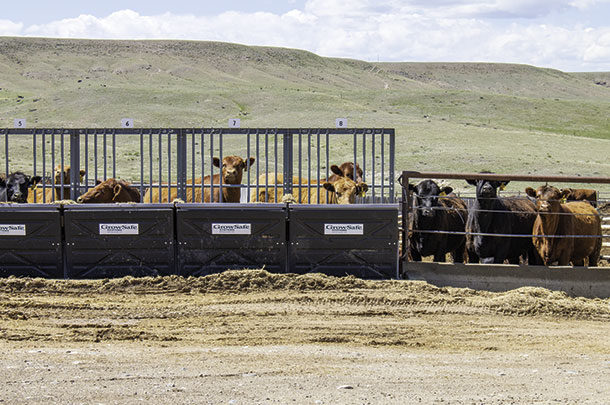Is residual feed intake (RFI) – a measure of feed efficiency – the missing, ignored, unknown or simply late-to-the-party selection trait in today’s cow herd? If it’s discussed, it’s normally offered as a way of selecting and grouping feedlot cattle. Cow-calf producers often tune it out as white noise.
Even for feedlots, the favorite means of measuring feed efficiency remain feed-to-gain and feed-conversion ratios, which work well for pen versus pen but don’t drill the process down to an individual basis.
Dr. Susan Markus, beef research scientist at Alberta Agriculture and Forestry, says there is still a large misunderstanding about the subject. “It’s often believed feed efficiency or RFI measurement is of most importance to a feedlot. In reality, it’s probably more important in the cow herd because we’re talking about animals that we basically provide maintenance rations for eight months and gestating or lactating rations for the other four. So if a cow is in our care for 365 days a year, for probably eight to 10 years, RFI is really an indication of the maintenance requirements of that animal, as we typically don’t require much gain from the breeding cows.”
RFI is calculated by subtracting the expected feed requirements for maintenance and growth from the actual intake of an individual animal, resulting in a low or negative number in the most efficient animals. Efficient (negative or low RFI) animals use less feed for a high average daily gain. Inefficient (positive or high RFI) animals consume a larger amount to match the same gain.
It is somewhat opposite of traits such as growth and carcass quality, which emphasize inputs to increase income. Factors to lower inputs like feed efficiency have often been overlooked, but it is a fact: Cow herd populations have a wide variation of efficiency between individual animals.
Feed savings and other benefits
Markus says savings can be realized on an ongoing basis, since feeding the cow herd is long term. “If we look at costs of production – feed, bedding and pasture – those related costs are about 70 percent of our total costs of production in a beef animal.”
She says gains continue when conditions are less than favorable. “In an efficient herd, you will also see a benefit when those cows are turned out on resource-limited situations, like swath grazing. Efficient females will actually do better in those situations than their inefficient counterparts.”
Other advantages include a decrease in manure and methane production, as emissions are directly proportional to dry matter intake. “We know if a cow eats less, she is going to produce approximately 15 percent to 20 percent less manure and 15 percent less methane. Feed-efficient cows are greener cows with a better carbon footprint.”
Placing RFI-efficient females into the cow herd
Efficient cows are diamonds in the rough, but they aren’t easy to extract from the general rubble.
Systems such as GrowSafe, which track water and feed intake through a computerized process and calculate individual consumption and weight gain, are the most accurate way to identify RFI-efficient cattle.
This process is popular with seedstock producers attempting to add a feed-efficiency trait index to their bulls’ expected progeny difference (EPD) numbers, but many breed associations are still in the process of establishing EPDs for the trait. For commercial cattlemen with larger numbers of animals, it can be cumbersome and expensive.
Markus says some producers test their replacement heifers, counting on the animal to remain in the herd for up to 10 years, but available bunk space is limited and costly with trials taking 40 to 70 days to ensure accurate measurements.
“The good thing is, I don’t need to do it that way. It works from the bull angle and genetic selection. I know it’s a moderately to highly heritable trait, so if I search out bulls with the other traits I like, plus those having a decent efficiency value, I’m going to breed it into my herd in time.”
“We still must test because we need to gather more information, but what we have now is technology using DNA and genomics, so when actual feed testing is done, it’s submitted into the database, which contributes to more accurate results.”
Markus describes other possibilities for adding RFI efficiency into the cow herd, but they currently lack accuracy. “We can find females with longevity and stayability traits – that might mean they could be more efficient. You can also get a reasonably priced DNA test analyzed and receive an estimated breeding value for a heifer with several traits addressed, such as maternal, growth and feed efficiency. It may not be as accurate because it’s trying to estimate from a number of snips in her DNA profile, but that’s where the technology is today.”
Hybrid vigor is also a potential approach, but there is much to be learned in this field. “Some of the research has found animals with more hybrid vigor have improved longevity and stayability, disease susceptibility and improved feed efficiency.” She says it’s not a quick route, but for the commercial cattleman, it can still lead down the path to more efficient animals.
Selecting for more than a single trait
Markus urges producers to select for a fleet of traits and not just a single one like RFI. “I’m not going to select a feed-efficient female with poor maternal traits. You have to put this in a package for trait selection because we don’t want to lose those economically important to our business.” Structural conformation, growth performance, fertility, longevity, docility and carcass quality top a long list of traits similarly vital to the animal and operation.
She sees RFI as a measure of feed efficiency becoming more critical to all variations of livestock production, with the use of DNA, genomic testing and systems like GrowSafe continuing to add measurements to the databases. “As we get more breeds creating RFI EPDs, the commercial cattleman will have more options to find feed-efficient animals in any breed they choose. But it all takes time and numbers to get accurate data.”









